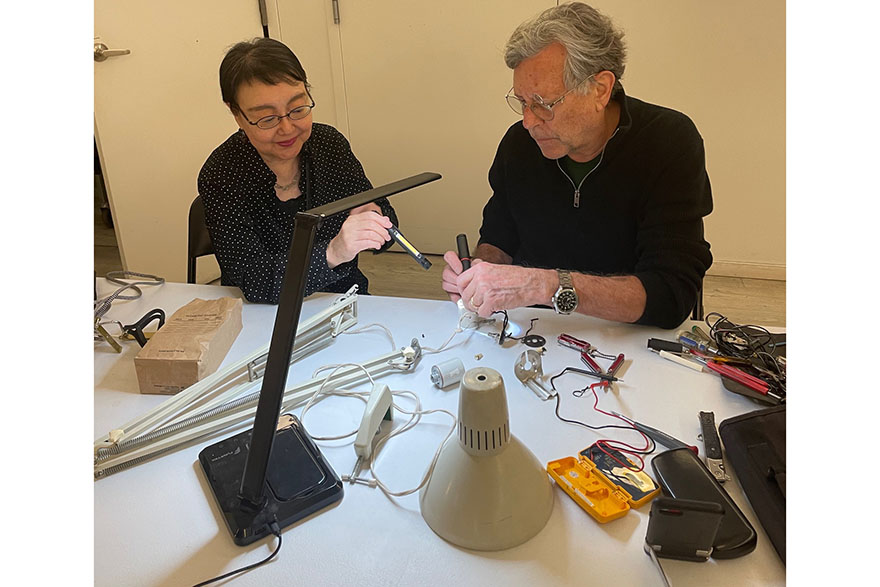
Is it junk? Or can it be salvaged? More and more folks are saving money and the environment repairing their broken items instead of consigning them to landfill and exercising their creativity as well.Hes my savior, said Junko Barrow about John Murphy (pictured above), who was fixing her Leda-brand lamp as they sat together at a table in the community room of Westbeth Artists Housing in Manhattan.(Westbeth is a NORC, a naturally occurring retirement community where many senior artists work into their 80s and beyond.)At a nearby table, Dennis Fitzpatrick, another Westbeth resident, was repairing an ornate chair someone found on the street.Its fun taking things apart, Fitzpatrick says.
You see the inventiveness that went into it and putting it back is reverse creativity.Paula Newman (at left), a West Village neighbor, had just mended a pretty dress for the granddaughter of a volunteer working the check-in desk.And another fixer was busy working on a broken printer.The Fix-It Night at Westbeth is a collaboration with the www.fixerscollective.org a local experiment in the growing international repair movement.Hundreds of similar events take place around the country under a concept known as Repair Caf.
(The idea started in Amsterdam 15 years ago and spread around the world.)But New Yorkers do their own thing.The Fixers Collectives geeky geniuses come to Westbeths five times yearly event, and created a neighborhood repair hot spot.This brings people together to help each other and keeps things out of the landfill, says Carole Braden, conservation chair, Westbeth Artists Residents Council and coordinator of Fix-It Night.Were empowering people to do their own repairs, Braden explains.You sit with the fixer and talk and learn how to use the tools.
And its social.Ive gone to events in Amsterdam and upstate New York.Repair creates a lovely community with a shared purpose.Braden, a journalist, wrote about the initial event in her building for a local paper; its only grown since then.Seniors Rule at Repair CafesWe have many senior volunteers, says Suzie Fromer, Repair Caf Coordinator, Hudson Valley, New York.
They have the time and the skills and they want to show people how valuable they are.The fixers tinker at home all the time.The movement is huge in this rural area in upstate New York; there are 70 cafes in towns in the Hudson Valley including New Paltz and Rhinebeck and Walkill, and hundreds of handy volunteers.Hudson Valley events offer tea and coffee and baked goods.
It is like a town square, says Fromer.Besides the environmental benefit, repairs save consumers money.I think with the economic downturn, there is more interest, says Fromer.We have a lot of retired seniors volunteering to help others fix their stuff, adds Wayne Seltzer, retired electrical engineer and founder of the Boulder U-Fix-It Clinic in Boulder, Colorado.Started in 2013, over 2,000 people have participated in the free clinics which often meet in a maker space (workshop) at the public library.
Many seniors bring their broken items.Many of our senior volunteers grew up in the midst of the ecology movement in the 60s,Seltzer says, so repair fits right in with Give a Hoot.Dont Pollute! Seniors remember when products lasted longer.Many products were designed to be easily repaired with parts and service manuals readily available.
Times have changed-products are complex, can be hard or impossible to repair, often by design.The FixesWhat gets fixed? Practically anything: lamps, vacuums, clocks, chairs, electrical items, small appliances, digital devices, clothing, textiles, toys, dolls, stuffed animals, or jewelry.Lamps are the most popular item at repair events.People are very attached to lamps, says Seltzer and electrical problems are scary.Lamp repair is a gateway to repair.
It is satisfying when the light goes on.The Boulder clinic uses recycled lamp cords for replacements and hands out LED bulbs.Next most popular are sewing/textile repairs such as hemming, patching, or replacing a zipper.Fixes can be as easy as lubing a table fan with oil in ten minutes or a multi-hour challenge.
Fromer has witnessed electrical/mechanical folks feeling wiped out at the end of a long session trying to fix something that they couldnt get working again.Long or challenging fixes include clocks and music boxes, Fromer notes.One cuckoo clock had so many things going on (people dancing out of the little door, music and lights) that the owner didnt even know it did those things!Microwaves are a big and potentially dangerous challenge.The Boulder clinic figured out an easy microwave repair involving a clear safety switch that can fail and can be easily replaced.
Their microwave guide is on their website.Most repair community repair people suggest staying away from lithium batteries.Braden notes the positive side of retired technical people finding a place to demonstrate their skills and of visitors having the opportunity to learn, even if its learning an item cant be fixed.It gives the owner permission to let it go.
Its a relief, she says.She informs people how to properly dispose of electronics.Gratitude and CreativityFromer, a jewelry maker, repairs earrings, necklaces and bracelets.Its tremendously creative to fix things quickly with what you have, she says.
The repair caf is like the emergency room and we do triage.Ive had people cry at being able to wear their broken jewelry again.Sometimes fixers have to get really creative.Someone brought a kitchen blender into the Boulder clinic.
A broken plastic piece was causing leaks.A fixer designed a plastic gasket on a 3D printer that solved the problem and shared the design on the internet so others can download and print it.Got stuff that still works but outlived its usefulness? Help the environment and share tips on alternatives to the junkyard with Senior Planet Communitys Decluttering group.Training OthersAll three coordinators that spoke with Senior Planet emphasized the training aspect.Most of our fixers love to talk about the process and teach others, Fromer says.
Thats a big part of why they come to demystify the process and give others the confidence to fix their own things.We want to get more people involved.Right to Repair LegislationAll 50 states now have Right to Repair laws, either passed or pending.Many fixers are active in in supporting this movement to create laws that require manufacturers- mostly of smart phones and other trashed electronics- to release parts and manuals for their products.Meanwhile, an organization called iFixit www.fixit.com offers thousands of free manuals, tutorials and teardowns on its website, and repair activists keep reviving stuff.
All around the country, fixers are working to help save the planet one lamp at a time!YOUR TURNWhat did you save from landfill thanks to your creativity? Share your experience in the comments!Kate Walter is the author of two memoirs:Behind the Mask: Living Alone in the Epicenter;andLookingfor a Kiss: A Chronicle of Downtown Heartbreak and Healing.Her essays and opinion pieces have appeared inThe New York Times, Newsday,New York Daily News, AM-NY, Next Avenue, The Advocate,The Village Sun and other outlets.She taught writing at CUNY and NYU for three decades and now works as a writing coach.Photo of Kate Walter by Su ZenPhoto credits, top and middle: Kate Walter;All photos were taken at Westbeth Fix It Night, March, 2025
Publisher: Senior Planet ( Read More )

